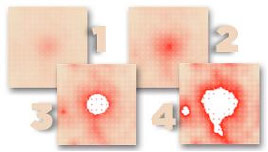Computer Simulation Predicts Development, Progress of Pressure Sores
 Researchers at the University of Pittsburgh School of Medicine have devised a computational model that could enhance understanding, diagnosis, and treatment of pressure ulcers related to spinal cord injury. In a report published online in PLOS Computational Biology, the team also described results of virtual clinical trials that showed that for effective treatment of the lesions, anti-inflammatory measures had to be applied well before the earliest clinical signs of ulcer formation.
Researchers at the University of Pittsburgh School of Medicine have devised a computational model that could enhance understanding, diagnosis, and treatment of pressure ulcers related to spinal cord injury. In a report published online in PLOS Computational Biology, the team also described results of virtual clinical trials that showed that for effective treatment of the lesions, anti-inflammatory measures had to be applied well before the earliest clinical signs of ulcer formation.
Pressure ulcers affect more than 2.5 million Americans annually and patients who have spinal cord injuries that impair movement are more vulnerable to developing them, said McGowan Institute for Regenerative Medicine faculty member and senior investigator Yoram Vodovotz, Ph.D., professor of surgery and director of the Center for Inflammation and Regenerative Modeling at the McGowan Institute.
“These lesions are thought to develop because immobility disrupts adequate oxygenation of tissues where the patient is lying down, followed by sudden resumption of blood flow when the patient is turned in bed to change positions,” Dr. Vodovotz said. “This is accompanied by an inflammatory response that sometimes leads to further tissue damage and breakdown of the skin.”
“Pressure ulcers are an unfortunately common complication after spinal cord injury and cause discomfort and functional limitations,” said co-author Gwendolyn A. Sowa, M.D., Ph.D., associate professor of physical medicine and rehabilitation, Pitt School of Medicine. “Improving the individual diagnosis and treatment of pressure ulcers has the potential to reduce the cost of care and improve quality of life for persons living with spinal cord injury.”
To address the complexity of the biologic pathways that create and respond to pressure sore development, the researchers designed a computational, or “in silico,” model of the process based on serial photographs of developing ulcers from spinal cord-injured patients enrolled in studies at Pitt’s Rehabilitation Engineering Research Center on Spinal Cord Injury. Photos were taken when the ulcer was initially diagnosed, three times per week in the acute stage, and once a week as it resolved.
Then they validated the model, finding that if they started with a single small round area over a virtual bony protuberance and altered factors such as inflammatory mediators and tissue oxygenation, they could recreate a variety of irregularly shaped ulcers that mimic what is seen in reality.
They also conducted two virtual trials of potential interventions, finding that anti-inflammatory interventions could not prevent ulcers unless applied very early in their development.
In the future, perhaps a nurse or caregiver could simply send in a photo of a patient’s reddened skin to a doctor using the model to find out whether it was likely to develop into a pressure sore for quick and aggressive treatment to keep it from getting far worse, Dr. Vodovotz speculated.
“Computational models like this one might one day be able to predict the clinical course of a disease or injury, as well as make it possible to do less expensive testing of experimental drugs and interventions to see whether they are worth pursuing with human trials,” he said. “They hold great potential as a diagnostic and research tool.”
The team included co-senior author Gary An, M.D., of the University of Chicago; Cordelia Ziraldo, Ph.D., Alexey Solovyev, Ph.D., Ana Allegretti, Ph.D., Shilpa Krishnan, M.S., McGowan Institute for Regenerative Medicine affiliated faculty member David Brienza, Ph.D., Qi Mi, Ph.D., all of Pitt; and M. Kristi Henzel, M.D., Ph.D., of the Louis Stokes Cleveland Veterans Affairs Medical Center.
Illustration: UPMC/University of Pittsburgh Schools of the Health Sciences.
Read more…
UPMC/University of Pittsburgh Schools of the Health Sciences Media Relations News Release
Full Text (A computational, tissue-realistic model of pressure ulcer formation in individuals with spinal cord injury. Cordelia Ziraldo, Alexey Solovyev, Ana Allegretti, Shilpa Krishnan, M. Kristi Henzel, Gwendolyn A. Sowa, David Brienza, Gary An, Qi Mi,Yoram Vodovotz. PLOS Computational Biology; published June 25, 2015.)
